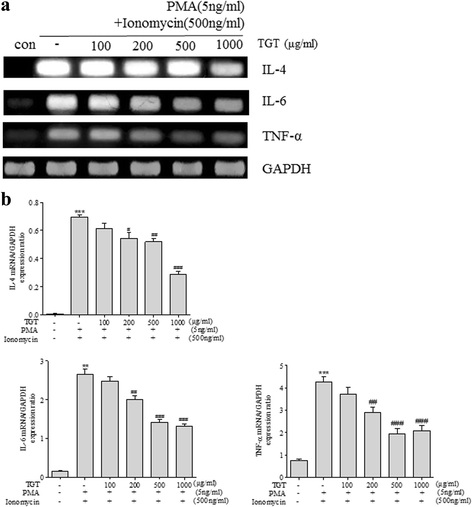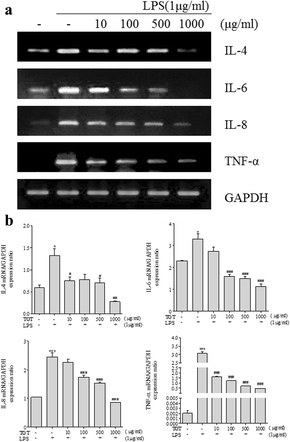Tonggyu-tang, a traditional Korean medicine, suppresses pro-inflammatory cytokine production through inhibition of MAPK and NF-κB activation in human mast cells and keratinocytes
- PMID: 28359265
- PMCID: PMC5374729
- DOI: 10.1186/s12906-017-1704-5
Tonggyu-tang, a traditional Korean medicine, suppresses pro-inflammatory cytokine production through inhibition of MAPK and NF-κB activation in human mast cells and keratinocytes
Abstract
Background: Allergic diseases including allergic rhinitis, asthma, and atopic dermatitis are increasing worldwide. Common medications used to treat these inflammatory disorders are anti-histamines and corticosteroids, but they have their own limitations such as short duration and severe side effects. Thus, interest in complementary and alternative medicine is continually growing. Here, we investigate the anti-inflammatory mechanisms of Tonggyu-tang (TGT), a traditional Korean medicine that has been used to treat patients with allergic nasal disorders.
Methods: We measured mRNA expressions and production of pro-inflammatory cytokines such as interleukin (IL)-4, IL-6, IL-8 and tumor necrosis factor alpha (TNF-α) by RT-PCR and ELISA assays in HMC-1 (human mast cell line-1) and HaCaT cells, immortalized human keratinocytes. Moreover, we evaluated the effect of TGT on two major inflammation-related pathways, mitogen activated protein kinase (MAPK) and NF-κB signaling pathway in these two cells.
Results: Our results revealed that that TGT significantly reduced the expression and production of inflammatory cytokines such as IL-4, IL-6, IL-8, and TNF-α in the agonist-treated HMC-1 and HaCaT cells. We also found that TGT suppressed MAPK signaling pathway including extracellular signal-regulated kinase (ERK), p38 mitogen-activated protein kinase (p38), and c-Jun N-terminal kinase (JNK) as well as NF-κB pathway, which are known to regulate inflammatory cytokine expression.
Conclusion: Taken together, our results demonstrate that TGT inhibits expression of pro-inflammatory cytokines by suppressing MAPK and NF-kB pathway in both mast cells and keratinocytes, suggesting the potential use of TGT in treating allergic inflammatory diseases.
Keywords: Anti-inflammation; HaCaT; Hmc-1; Mapk; NF-κB; Tonggyu-tang.
Figures





Similar articles
-
Anti-inflammatory effect of leaves of Eriobotrya japonica correlating with attenuation of p38 MAPK, ERK, and NF-kappaB activation in mast cells.Toxicol In Vitro. 2009 Oct;23(7):1215-9. doi: 10.1016/j.tiv.2009.07.036. Epub 2009 Aug 7. Toxicol In Vitro. 2009. PMID: 19665545
-
Curcumin derivative, 2,6-bis(2-fluorobenzylidene)cyclohexanone (MS65) inhibits interleukin-6 production through suppression of NF-κB and MAPK pathways in histamine-induced human keratinocytes cell (HaCaT).BMC Complement Altern Med. 2018 Jul 16;18(1):217. doi: 10.1186/s12906-018-2223-8. BMC Complement Altern Med. 2018. PMID: 30012134 Free PMC article.
-
Illicium verum extract inhibits TNF-α- and IFN-γ-induced expression of chemokines and cytokines in human keratinocytes.J Ethnopharmacol. 2012 Oct 31;144(1):182-9. doi: 10.1016/j.jep.2012.08.049. Epub 2012 Sep 7. J Ethnopharmacol. 2012. PMID: 22974545
-
Rac mediates TNF-induced cytokine production via modulation of NF-kappaB.Mol Immunol. 2008 May;45(9):2446-54. doi: 10.1016/j.molimm.2007.12.011. Epub 2008 Feb 6. Mol Immunol. 2008. PMID: 18258304 Review.
-
Exploring the Role of Licorice and Its Derivatives in Cell Signaling Pathway NF-κB and MAPK.J Nutr Metab. 2024 Oct 23;2024:9988167. doi: 10.1155/2024/9988167. eCollection 2024. J Nutr Metab. 2024. PMID: 39479405 Free PMC article. Review.
Cited by
-
Chinese liquor extract attenuates oxidative damage in HepG2 cells and extends lifespan of Caenorhabditis elegans.Food Sci Nutr. 2020 May 23;8(7):3164-3172. doi: 10.1002/fsn3.1564. eCollection 2020 Jul. Food Sci Nutr. 2020. PMID: 32724581 Free PMC article.
-
Network Pharmacology Identifies the Mechanisms of Sang-Xing-Zhi-Ke-Fang against Pharyngitis.Evid Based Complement Alternat Med. 2020 Oct 12;2020:2421916. doi: 10.1155/2020/2421916. eCollection 2020. Evid Based Complement Alternat Med. 2020. PMID: 33101439 Free PMC article.
-
Alpinetin: A Review of Its Pharmacology and Pharmacokinetics.Front Pharmacol. 2022 Feb 4;13:814370. doi: 10.3389/fphar.2022.814370. eCollection 2022. Front Pharmacol. 2022. PMID: 35185569 Free PMC article. Review.
-
Taeumjowi-tang, a Traditional Korean Sasang Remedy, Improves Obesity-Atopic Dermatitis Comorbidity by Regulating Hypoxia-Inducible Factor 1 Alpha.Front Pharmacol. 2019 Dec 20;10:1458. doi: 10.3389/fphar.2019.01458. eCollection 2019. Front Pharmacol. 2019. PMID: 31920651 Free PMC article.
-
Use of Natural Products in Asthma Treatment.Evid Based Complement Alternat Med. 2020 Feb 13;2020:1021258. doi: 10.1155/2020/1021258. eCollection 2020. Evid Based Complement Alternat Med. 2020. PMID: 32104188 Free PMC article. Review.
References
-
- Bradding P, Feather IH, Wilson S, Bardin PG, Heusser CH, Holgate ST, et al. Immunolocalization of cytokines in the nasal mucosa of normal and perennial rhinitic subjects. The mast cell as a source of IL-4, IL-5, and IL-6 in human allergic mucosal inflammation. J Immunol. 1993;151(7):3853–3865. - PubMed
MeSH terms
Substances
LinkOut - more resources
Full Text Sources
Other Literature Sources
Research Materials
Miscellaneous

